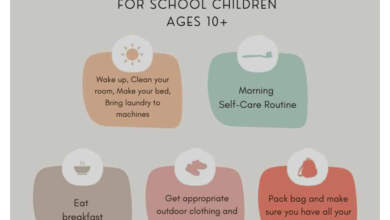How to Build a Sleep Routine for Kids That Works Every Night
Sleep routine for kids that works Discover expert tips to establish healthy bedtime habits for peaceful nights and happy, rested children.

Establishing a sleep routine for kids is one of the most important yet challenging tasks for parents. A consistent bedtime schedule not only ensures your child gets the rest they need but also supports their growth, mood, and cognitive development. Without proper sleep, children may struggle with irritability, difficulty concentrating, and even weakened immunity. This guide will walk you through practical, science-backed strategies to create a sleep routine for kids that works night after night, turning bedtime battles into peaceful moments of relaxation.
The key to success lies in Sleep Routine, consistency, and a calming environment. Children thrive on predictability, and a structured wind-down process signals to their brain that it’s time to sleep. From setting the right bedtime to incorporating soothing pre-sleep activities, every step plays a crucial role. Whether your child is a toddler resisting bedtime or a school-aged kid who can’t seem to unwind, these proven techniques will help you design a sleep routine for kids that promotes deep, restful sleep every single night.
How to Build a Sleep Routine for Kids That Works Every Night
Understand the Importance of a Consistent Sleep Schedule
Children thrive on routine, and sleep is no exception. A regular bedtime and wake-up time help regulate their circadian rhythm, the body’s natural sleep-wake cycle. When this rhythm is disrupted, kids may experience difficulty falling asleep or waking up groggy. Studies show that children with consistent sleep schedules have better attention spans, improved memory, and fewer behavioral issues. To establish this, choose a bedtime that allows for the recommended hours of sleep based on their age typically 9-12 hours for school-aged kids.
Create a Calming Pre-Bedtime Routine
A wind-down routine signals to your child’s brain that it’s time to relax. Start this process 30-60 minutes before bed with calming activities like reading a book, taking a warm bath, or practicing gentle stretches. Avoid stimulating activities such as screen time, rough play, or sugary snacks, as these can delay sleep. Incorporating relaxation techniques like deep breathing or soft lullabies can further ease the transition to sleep. The key is consistency repeating the same steps nightly reinforces the association between these activities and bedtime. Over time, this predictability helps children feel secure and ready for sleep.
Optimize the Sleep Environment
A child’s bedroom setup plays a crucial role in sleep quality. Ensure the room is dark, quiet, and cool ideally between 65-70°F (18-21°C). Blackout curtains can block outside light, while a white noise machine masks disruptive sounds. The bedding should be comfortable and safe, with a supportive mattress and breathable blankets. If your child is afraid of the dark, a small nightlight with a warm glow can provide reassurance without interfering with melatonin production. Keeping the room clutter-free also minimizes distractions that could keep them awake.
Limit Screen Time Before Bed
Electronic devices emit blue light, which suppresses melatonin, the hormone responsible for sleepiness. To prevent this, establish a digital curfew at least one hour before bedtime. Replace TV or tablet time with quiet activities like puzzles, coloring, or storytelling. If your child uses a device for homework, enable blue light filters or encourage them to finish earlier in the evening. Setting this boundary not only improves sleep but also reduces Mental record, making it easier for them to unwind.
Encourage Daytime Physical Activity
Regular exercise helps children expend energy, making it easier for them to fall asleep at night. Encourage at least 60 minutes of active play, whether it’s running, biking, or playing sports. However, avoid vigorous activity too close to bedtime, as it can have the opposite effect. Outdoor play is especially beneficial because exposure to natural light helps regulate the sleep-wake cycle. Just be mindful of timing morning or afternoon sunlight is ideal, while evening sunlight might delay sleepiness.
Monitor Food and Drink Intake
Diet plays a significant role in sleep quality. Avoid caffeine (found in chocolate, soda, and some teas) in the afternoon and evening, as it can linger in a Family-friendly for hours. Heavy meals right before bed may also cause discomfort. Instead, offer a light bedtime snack like bananas, oatmeal, or warm milk, which contain sleep-promoting nutrients like magnesium and tryptophan. Hydration is important, but limit liquids an hour before bed to prevent nighttime bathroom trips.
Address Fears and Anxiety
Some children resist bedtime due to nighttime fears or separation anxiety. Listen to their concerns and offer reassurance without dismissing their feelings. A comfort object, like a stuffed animal or blanket, can provide security. For persistent anxiety, try visualization exercises or a “worry jar” where they can write down concerns before bed. If nightmares are an issue, discuss happy thoughts or read uplifting stories to shift their mindset before sleep.
Be Patient and Consistent
Change Takes Time
Building new habits requires patience – children’s biological clocks don’t adjust instantly. Expect 2-4 weeks of consistent practice before seeing solid results. Small improvements each night signal progress is happening, even if slowly.
Stick to the Plan Rigidly
Consistency is everything – maintain identical bedtime/wake-up times daily, including weekends. Follow the exact same pre-sleep routine sequence every single night. Resist making exceptions, as they confuse a child’s internal clock and undo progress.
Handle Setbacks Calmly
Nighttime wake-ups or resistance are normal – respond with gentle redirection, not punishment. Keep interactions boring and brief during any nighttime disturbances. Track patterns over weeks rather than reacting to single bad nights.
Involve Your Child
Use visual charts to help children track their own sleep progress. Offer small rewards for consecutive nights of good sleep habits. Give appropriate choices (“Which pajamas?” not “Bedtime?”) to build cooperation.
Adjust Gradually
If changing an existing routine, shift bedtimes in 15-minute increments. Modify one element at a time to identify what works best. Remember that developmental changes may require routine tweaks over time.
Model Good Habits
Demonstrate your own consistent sleep schedule and wind-down routine. Keep household evenings calm as bedtime approaches. Children imitate what they see – be the sleep behavior you want to teach.
Seek Support When Needed
Partner with other caregivers to maintain identical Sleep Routine. Consult pediatricians if sleep problems persist beyond 6 weeks. Remember most sleep challenges are phase that pass with time and consistency.
Read More: 10 Surprising Foods That Boost Your Child’s Brain Development
Conclusion
Creating a sleep routine for kids that works consistently requires patience and commitment, but the long-term benefits make it well worth the effort. When children follow a structured bedtime schedule, they enjoy better focus, improved mood, and stronger overall health. By implementing the strategies outlined from setting consistent bedtimes to creating a calming pre-sleep environment you can transform restless nights into peaceful, restorative sleep for your little one. Remember, every child is different, so don’t be discouraged if adjustments are needed along the way.
The key to success with a sleep routine for kids lies in repetition and positive reinforcement. Over time, these habits become second nature, helping your child fall asleep faster and stay asleep longer. Whether it’s limiting screen time, incorporating relaxing activities, or maintaining a sleep-friendly bedroom, small changes can make a big difference. Stick with it, stay consistent, and soon you’ll have a Sleep Routine that works effortlessly night after night. Sweet dreams await.
FAQs
What time should kids go to bed?
Most children need bedtime between 7-9 PM, depending on age and wake-up time, to ensure 9-12 hours of quality sleep.
How can I make my child fall asleep faster?
Establish a consistent sleep routine with calming activities like reading or warm baths, and ensure their bedroom is dark and quiet.
Should kids nap during the day?
Younger children benefit from naps, but limit them to early afternoon and keep them short (1-2 hours) to avoid nighttime sleep disruptions.
What if my child wakes up at night?
Use gentle reassurance and avoid stimulating interactions—keep lights dim and return them to bed calmly to reinforce the sleep routine.
How long does it take for a new sleep routine to work?
Most children adapt within 2-3 weeks of consistent practice, though some may need longer—patience and repetition are key.











